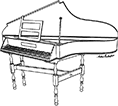Hints on Playing the Spinet, Virginal or Harpsichord
First Exercises
If you are seated at a harpsichord, always work with a single 8' register (on the lower manual if there are two); adding registers increases the resistance of the key. The fingers should be curved so that they approach the key at right angles to the keyboard. Practice feeling the resistance of the key with simple chords, aiming to overcome this resistance with just enough attack to sound the chord evenly and together. The fingers should never attack the key with greater force than is necessary - this achieves nothing and will produce a noise as the jacks hit the felted jack rail. One should think of firmly and evenly stroking the plectrum past the string.
Touch
Plucked instrument touch is all about phrasing and articulation - the length of each note - while piano touch is about depth, dynamic levels, legato and staccato. Plucked instrument touch is concerned solely with finger action - how the fingers go down and when they are released from the key; piano touch is more concerned with the weight of arm and hand. Chords with several notes can sound heavy; these may usefully be evenly spread to soften their percussive effect.
Articulation
The basic style of playing is for each note to be detached. Play a scale slowly, listening carefully to ensure that that there is a small silence of sound between each note. As there is no facility for playing a note louder or softer this is achieved by articulation - the length of the note. A scale of eight even quavers, for example, would be played with the first of every four notes having a longer length of sound than the subsequent three. Remember that, although detached notes may be regarded as the basic sound, a legato is often called for. To stress a note, shorten the note before it; to weaken a note, join it to the previous one. A pianistic staccato, or a continuous legato, is generally inappropriate to most music on the plucked keyboard instruments - always be conscious of the length you are giving to each note. Two-part music (Bach: Anna Magdalena Notebook; simple Handel or Purcell movements) makes good initial studies.
Virginal music
A consistently detached articulation is correct for the early music; articulation which contrasts detached and legato notes is needed in the later repertoire.
Registration
Changes of registration on larger harpsichords should be made with discretion. Altering registration within a movement should be avoided unless specifically indicated by the composer (usually with forte or piano markings). The single 8' on the lower manual provides the basic sonority, except in early Italian music, where the two 8' registers are often coupled.
Performance Practice
A knowledge of appropriate ornamentation and performance practice should go hand in hand with the learning of new music. An increasingly useful skill, with the number of facsimiles that are available, is that of continuo playing from figured bass and this should be part of any harpsichordist's art. The bibliography lists several books which deal in detail with these subjects.
